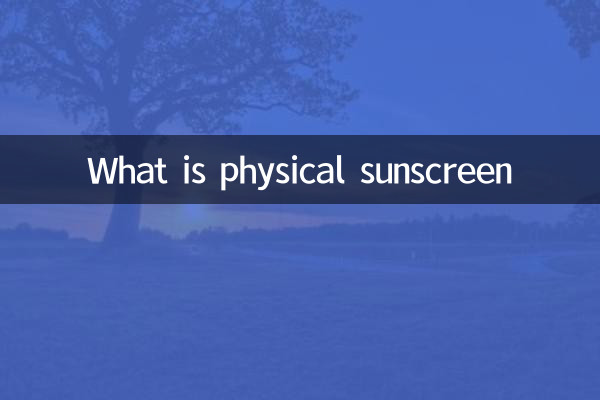What is physical sunscreen
With the arrival of summer, sun protection becomes the focus of people's attention. In recent years, physical sunscreens have become more and more popular among consumers due to their safety and mildness. This article will introduce in detail the definition, ingredients, advantages and disadvantages and usage methods of physical sunscreen, and combine it with the hot topics and hot content on the Internet in the past 10 days to provide you with comprehensive science popularization.
1. Definition of physical sunscreen

Physical sunscreen, also known as mineral sunscreen, is a product that achieves sun protection effects by reflecting or scattering ultraviolet rays. Its main ingredients are zinc oxide (Zinc Oxide) and titanium dioxide (Titanium Dioxide). These two ingredients can form a protective film on the skin surface to directly block ultraviolet rays.
2. Physical sunscreen vs chemical sunscreen
In order to understand the difference between physical sunscreen and chemical sunscreen more intuitively, the following is a comparison table between the two:
| Comparative item | physical sunscreen | chemical sunscreen |
|---|---|---|
| Sun protection principle | Reflect or scatter UV rays | Absorbs UV rays and converts them into heat |
| Main ingredients | Zinc oxide, titanium dioxide | Oxybenzone, avobenzone, etc. |
| Onset of effect | Effective immediately | Need to wait 15-30 minutes |
| Applicable people | Sensitive skin, pregnant women, children | normal skin |
| persistence | Reapply after sweating or swimming | usually more durable |
3. Advantages and disadvantages of physical sunscreen
advantage:
1. High safety: The ingredients of physical sunscreen are usually not absorbed by the skin and are suitable for sensitive skin and children.
2. Instant protection: It takes effect immediately after application, no need to wait.
3. Strong stability: not easily decomposed by ultraviolet rays, and the sun protection effect is longer-lasting.
shortcoming:
1. Thick texture: may leave white residue, affecting appearance.
2. Need to reapply frequently: it easily falls off after sweating or swimming.
4. How to choose and use physical sunscreen
1.Choose the appropriate SPF value:You can choose SPF30 for daily commuting, and SPF50+ is recommended for outdoor activities.
2.Pay attention to the ingredient list:Make sure the main ingredient is zinc oxide or titanium dioxide and avoid adding alcohol or fragrance.
3.Correct application method:Apply evenly to face and body and reapply every 2 hours.
5. Hot topics and content on the entire network
According to statistics from the past 10 days, the following are the hot discussion points about physical sunscreens:
| hot topics | Discussion popularity | Main point |
|---|---|---|
| Is physical sunscreen suitable for oily skin? | high | Most users believe that choosing products with light texture can avoid acne breakouts. |
| Environmental protection of physical sunscreen | middle | Some brands launch biodegradable formulas to reduce pollution to the ocean |
| Recommended sunscreen for children | high | Physical sunscreen becomes the first choice for mothers |
| The whitening problem of physical sunscreen | middle | New technologies such as nano-zinc oxide improve this problem |
6. Summary
Physical sunscreen has become a popular choice for summer sun protection due to its safety and instant protective effect. Despite the shortcomings of thick texture, as formulas improve, more and more brands have launched products that are thin and easy to push. Consumers can choose suitable physical sunscreen according to their own needs, and pay attention to correct use and re-applying to achieve the best sun protection effect.

check the details

check the details